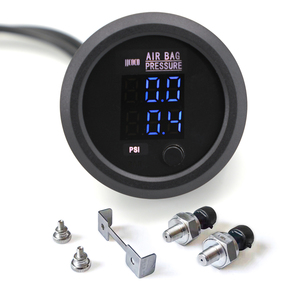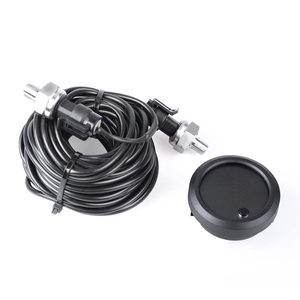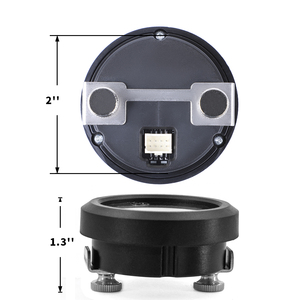
All categories
Featured selections
Trade Assurance
Buyer Central
Help Center
Get the app
Become a supplier

(15558 products available)



































The bar pressure gauge is an instrument used to measure and display an object's pressure. This pressure gauge indicates the pressure absorbed by an object in bars. One bar is roughly equal to atmospheric pressure at sea level. If there are any changes in the object's pressure, the bar pressure gauge will change accordingly.
Here are some common types of bar pressure gauges for sale:
Mechanical bar pressure gauge
A mechanical bar pressure gauge is an analogue instrument that indicates an object's pressure using a needle on a dial. It has a Bourdon tube that responds to changes in pressure. The tube is coiled and straightened when changes in pressure occur. This movement is then transferred through gears to move the needle on the dial. One advantage of the mechanical bar pressure gauges is that they are easy to read and inexpensive.
Digital bar pressure gauge
A digital bar pressure gauge uses electronic sensors to measure an object's pressure. The sensor converts the pressure into an electrical signal, which is then processed and displayed on a digital screen. The digital bar pressure gauge is very precise and gives reading to decimal points. It is also easy to use and read compared to mechanical gauges. However, it may cost more than the mechanical gauge.
Absolute pressure gauge
The absolute pressure gauge measures the pressure concerning a perfect vacuum. It takes into consideration the atmospheric pressure. This makes it very accurate for scientific applications as it provides precise measurements. Ideally, the absolute pressure gauge uses a digital display.
Differential pressure gauge
This gauge measures the difference between two pressures. For example, the difference between inside and outside a vessel. It also uses a digital display offering accurate readings.
Hydraulic pressure gauges
These gauges measure the pressure of liquids in hydraulic systems. They are often used in heavy machinery and automotive applications. A hydraulic pressure bar gauge can either be mechanical or digital.
Manifold pressure gauge
These gauges measure the pressure of gases in manifold systems. They are used in applications involving gas mixtures and pipelines. A manifold pressure bar gauge can either be mechanical or digital.
Specifications for a barometer gauge can vary. The following details are some of the more common specifications for a pressure gauge.
Functional range
This is the range of measurable pressures. The functional range will vary by the type of gauge.
Dial dimensions
The diameter of the dial can differ. Some typical dimensions are 40, 50, 63, 75, 100, 125, 150, 160, 200 mm. The longer needles are more visible from the dial.
Connection size
This refers to the parts that attach to the machine. Connection sizes can differ, such as 1/8NPT, 1/4 NPT, 1/4 BSP, M10x1. Other connection types are IP65 and 27NPT.
Thread form
Thread forms create strong seals so that no fluids leak out during operation. The common thread is NPT or National Pipe Thread. NPT is a tapered thread used in piping systems.
Operating temperature
This is the measurable temperature function of the gauge. The temperature has been calibrated. Some operations may be between -40 & 70 centigrade.
IP Rating
The Ingress Protection Rating shows how secure the product is against sand and water. Typical ratings are IP65 and IP67. IP65 means it is protected against dust and low-pressure water. IP67 means it is dust-tight and can operate under 1 meter of water.
Proper use of the Pressure gauges is important to get accurate readings. A few tips for maintaining the pressure gauge are as follows:
There are several applications of using bar pressure gauges in different industries and sectors. Here are some of them:
Industrial Process Control
Industrial factories like oil and chemical processing plants use bar pressure gauges to monitor pressure in pipelines, vessels, pumps, and compressors. The devices provide real-time feedback to automate pressure control valves, ensuring chemicals maintain the right concentration and that mechanical equipment functions seamlessly.
Hydraulic and Pneumatic Systems
Hydraulic systems operating heavy industrial machinery, automobiles, and aerospace equipment rely on bar pressure gauges. The devices help monitor fluid pressure to ensure proper functioning of hydraulic cylinders, pumps, and motors.
Construction and Structural Monitoring
Bar pressure gauges are used in construction to monitor pressure in concrete during curing. This prevents cracks and ensures structural integrity. The devices are also used in geo-tech applications to monitor soil and foundation stability, preventing landslides and ensuring safety of nearby structures.
Environmental Monitoring
Bar pressure gauges are used in environmental monitoring to measure barometric pressure. This assists in weather forecasting and calibrating meteorological instruments. In groundwater monitoring, the devices help monitor piezometric pressure to ascertain aquifer levels and hydrology analysis.
Food and Beverage Industry
Bar pressure gauges are commonly used in the food and beverage industry during food packaging. The devices help monitor and control pressure in food processing equipment like pasteurizers and homogenizers. Bar pressure gauges are also used in breweries to monitor fermentation tanks and carbonation levels in beverages.
Medical and Healthcare Applications
In the medical field, bar pressure gauges are used in ventilators to monitor and control breathing pressure for patients. The devices ensure the right pressure is delivered to patients' lungs. Bar pressure gauges are also used in infusion pumps to monitor fluid pressure. This ensures seamless and accurate delivery of liquids to patients.
When selecting a bar pressure gauge, several factors need to be considered to ensure that the gauge will meet the application's needs. The most critical factors to consider when choosing a barometer pressure gauge are as follows.
Application requirement
It is essential to determine the application's requirement before purchasing a bar pressure gauge. Buyers should consider the medium they want to measure and the environmental condition of the intended application. They should also think about the required range and pressure unit.
Gauge type
Once the application requirements have been established, it is necessary to determine the suitable type of bar pressure gauge for the job. This is because different bar pressure gauge types suit different application requirements. For instance, an analog gauge will be appropriate for industrial machines with low-pressure systems and harsh environments. In contrast, a digital gauge will be perfect for high-pressure systems with complexities.
Construction material
The construction material of a bar pressure gauge affects its functionality and durability. Choosing the right material can enhance a gauge's performance and lifespan. That's why it is essential to select a gauge material that can withstand the medium's conditions. Ideally, the material should resist corrosive substances, extreme temperatures, and harsh environmental factors.
Accuracy and resolution
A buyer's application may require a pressure gauge with a specific accuracy and resolution. For instance, industrial and laboratory applications usually require a gauge with high accuracy and a fine resolution. Choosing a gauge with the right accuracy and resolution can improve measurement reliability and ensure optimal application performance.
Display options
Bar pressure gauges usually have two common display options - digital and analog. As discussed earlier, each type of gauge suits different application specifications. If a buyer is unsure, they can ask their supplier for professional advice. The supplier will recommend the best gauge for their intended application.
Q1: How does a bar pressure gauge works?
A1: A bar pressure gauge is based on the concept of measuring external force/weight applied on an area. The atmospheric pressure exerts a force on the column of liquid in the open arm causing it to rise in the other closed arm. The vertical rise of liquid in the closed arm is the measure of the exerted pressure in ''bar''.
Q2: Is PSI the same as bar pressure gauge?
A2: Although closely related, they are different. PSIs are used in the United States to measure pressure, while bars are the metric used in Europe. 1 bar equals 14.5 PSI. Hence, 1 bar gauge pressure is equal to 14.5 pounds per square inch.
Q3: Which pressure gauge is done in the car?
A3: The tire pressure gauges are done in every vehicle to monitor its condition and ensure proper maintenance. Other pressure gauges look like the car dashboard. They are called ''manometer pressure gauges''.
Q4: What are the limitations of using a bar pressure gauge?
A4: The limitations of the bar pressure gauge are as follows: it cannot be used to measure low pressures, its cost is high, and it is considered complex compared to mechanical gauges.
Q5: What industries primarily use bar pressure gauges?
A5: The bar pressure gauge is widely used in industrial sectors such as oil and gas extraction, healthcare, automotive manufacturing, and food and beverage production, among others.